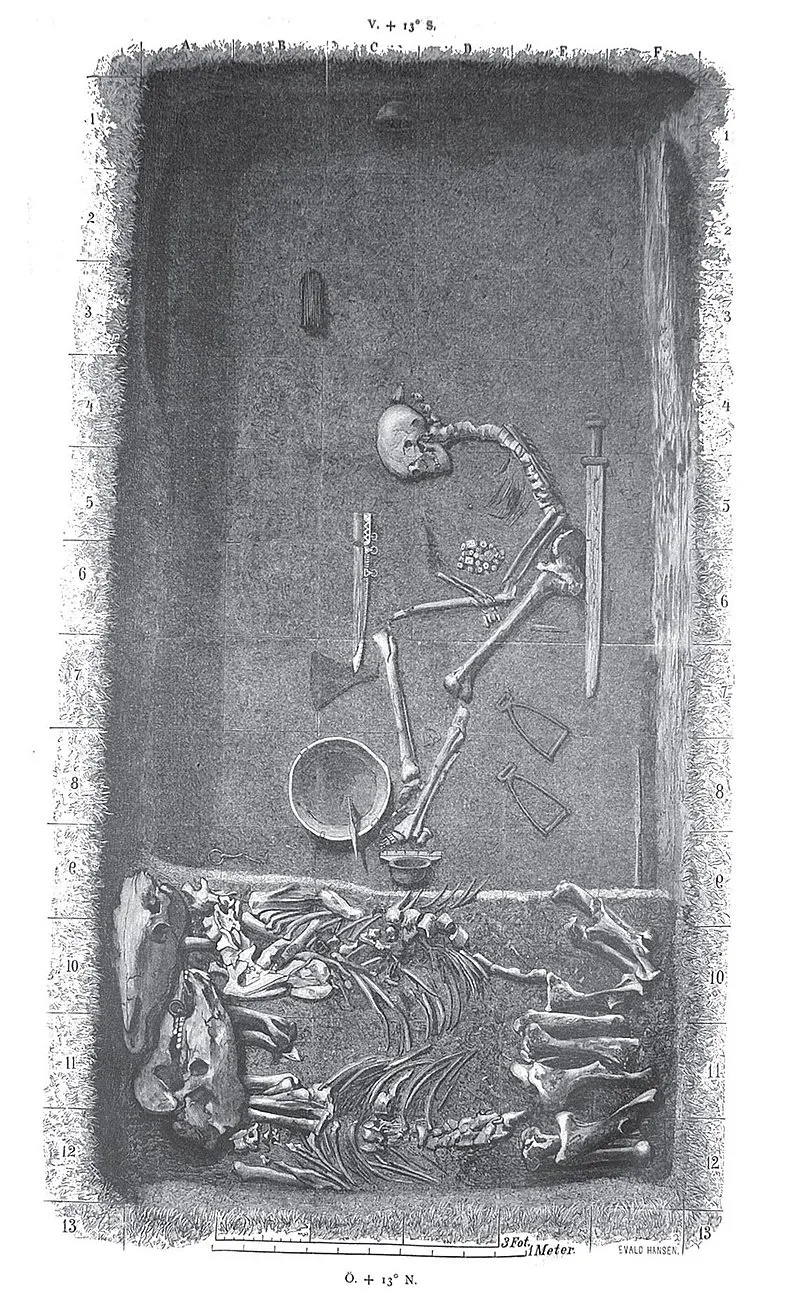Researchers Reaffirm Remains in Viking Warrior Tomb Belonged to a Woman
In new paper, the authors behind the 2017 study echo their original conclusions and delve deeper into the secrets of the grave in the Viking town of Birka
/https://tf-cmsv2-smithsonianmag-media.s3.amazonaws.com/filer/4c/cf/4ccf5c83-d32b-4117-abbd-be04d51376b6/vikingwomenwarrior_1024.jpg)
In 1878, archaeologists excavating the Viking town of Birka, Sweden, uncovered a singular ornate 10th-century burial tomb believed to hold the remains of a great warrior.
The site was filled with a trove of weapons, including a sword, spear, shield and two horses, as well as a game board likely used to map out military strategies. Further emphasizing its noteworthiness, out of 1,100 Birka tombs identified on the settlement, it was just one of two that contained a full set of weaponry.
If the final resting place wasn’t enough to convince you of the deceased's unique societal status, consider this: As History.com’s Becky Little reports, researchers have definitively concluded the soldier in question was not, as was long assumed, a man.
Guided by comprehensive genomic sequencing, archaeologists first revealed the unexpected findings of the woman warrior in a 2017 study published in the American Journal of Physical Anthropology. But as Live Science’s Laura Geggel explains, naysayers immediately unleashed a storm of criticism, alternately questioning whether the researchers had analyzed the correct set of bones, overlooked the presence of a male warrior sharing the grave, or failed to consider if the grave actually belonged to a transgender man.
Now, the authors of the original paper have released a follow-up study, newly published in Antiquity, reaffirming their original conclusions and delving deeper into the secrets of the grave. The latest batch of research addresses many of the concerns raised by critics; at the same time, Little notes, the paper acknowledges the difficulty of assessing gender roles and identity in such a long-ago culture.
According to the study, the grave offers ample evidence of its resident’s high-status in the military. The weapons left in the tomb—specifically, a sword, axe, fighting knife, lances, shields and 25 armor-piercing arrows—are present in an “unusual profusion and variety,” pointing toward the deceased’s likely career as an experienced mounted archer. Domestic tools one might more closely associate with Viking women are, on the other hand, absent from the grave.
Adding to these clues are the inclusion of a full gaming set, complete with three antler dice and 28 playing pieces, and the assumed warrior’s attire. As the authors write, complete game sets are often found in relation to Viking military leaders, while the textiles and tasseled cap worn by the individual are suggestive of cavalry commanders “under the immediate authority of a royal war-leader.”
Finally, as Geggel observes for Live Science, the location of the tomb at the westernmost reaches of Birka suggests it was visible from both the sea and the town. Marked by a large stone boulder, the site would have been known to all as the grave of a likely high-ranking member of the community.

Much of the justification for the proposed warrior’s misidentification as biologically male stems from past archaeologists’ frequent assignment of sex on the basis of a grave’s contents rather than scientific bone analysis, as Science Alert’s Carly Cassella argues. It’s worth noting, the authors point out in the new study, that at the time of the grave’s discovery, “male biological sex was not only conflated with a man’s gendered identity, but also that warriorhood was presumed to be an exclusively masculine pursuit.”
As Michael Greshko explained for National Geographic in 2017, Viking mythology has long touted the existence of female warriors. But it took a team led by Charlotte Hedenstierna-Jonson, an archaeologist at Sweden’s Uppsala University, to fully dispute the idea that such individuals were limited to fiction. After extracting the roughly 1,000-year-old warrior’s mitochondrial and nuclear DNA, the researchers found no traces of Y chromosomes indicative of male biological sex. In a further negation of critics’ comments, they also concluded that the mitochondrial DNA from all bones tested matched—and therefore belonged to one XX individual.
According to History.com’s Little, one of the main questions raised by critics of the 2017 study was whether the warrior was a transgender man. The authors address this in the new paper, writing, “[Transgender] is a modern politicized, intellectual and Western term, and as such, is problematic … to apply to people of the more remote past.” That being said, the researchers are quick to note it’s impossible to discount any of the “many other possibilities across a wide gender spectrum, some perhaps unknown to us, but familiar to the people of the time.”
Live Science’s Geggel writes that alternative explanations for the singular burial include the theory that the weapons buried alongside the woman were not reflective of her role in life, or perhaps represented a symbolic proxy identity. Still, the study's authors conclude, the most “obvious and logical conclusion” is that the individual in question was a woman who lived as a professional warrior and was buried in accordance with this rank.
Speaking to Little, Hedenstierna-Johnson offers a final overarching counter-argument to the controversy: “Since [the site] was excavated in the 1870s, it has constantly been interpreted as a warrior grave because it looks like a warrior grave and it’s placed by the garrison and by the hillfort,” she says. “Nobody’s ever contested it until the skeleton proved to be female, and then it was not a valid interpretation anymore.”
/https://tf-cmsv2-smithsonianmag-media.s3.amazonaws.com/accounts/headshot/mellon.png)
/https://tf-cmsv2-smithsonianmag-media.s3.amazonaws.com/accounts/headshot/mellon.png)